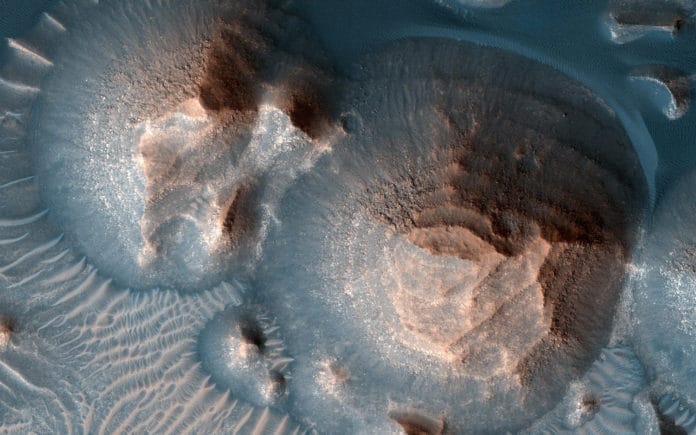Some volcanoes are so powerful that they release a huge amount of dust and toxic gases into the air. This blocks sunlight and changes a planet’s climate for decades. By studying topography and mineral composition of a piece of the Arabia Terra area in northern Mars, scientists recently discovered proof for thousands of such eruptions, or ‘super-eruptions.’
Along with emitting water vapor, carbon dioxide, and sulfur dioxide in the air, these explosions tore through the Martian surface over a 500-million-year period about 4 billion years ago. Each eruption had a significant climate impact.
Patrick Whelley, a geologist at NASA‘s Goddard Space Flight Center in Greenbelt, Maryland, who led the Arabia Terra analysis, said, “Each one of these eruptions would have had a significant climate impact — maybe the released gas made the atmosphere thicker or blocked the Sun and made the atmosphere colder. Modelers of the Martian climate will have some work to do to try to understand the impact of the volcanoes.”
Seven calderas in Arabia Terra were the first giveaways that the region may once have hosted volcanoes capable of super-eruptions.
For this study, scientists used the data from NASA’s Mars Reconnaissance Orbiter to find ash elsewhere on Mars, so she partnered with Whelley and his team to look specifically in Arabia Terra.
The analysis followed up on other scientists who earlier suggested that the minerals on the surface of Arabia Terra were volcanic in origin. Another research group, upon learning that the Arabia Terra basins could be calderas, had calculated where ash from possible super-eruptions in that region would have settled: traveling downwind, to the East, it would thin out away from the center of the volcanoes, or in this case, what’s left of them: the calderas.
Alexandra Matiella Novak, a volcanologist at the Johns Hopkins Applied Physics Laboratory in Laurel, Maryland, said, “So we picked it up at that point and said, ‘OK, well these are minerals that are associated with altered volcanic ash, which has already been documented, so now we’re going to look at how the minerals are distributed to see if they follow the pattern we would expect to see from super-eruptions.”
Using images from MRO’s Compact Reconnaissance Imaging Spectrometer, scientists identified the minerals in the surface. Looking in the walls of canyons and craters from hundreds to thousands of miles from the calderas, where the wind would have carried the ash, they identified volcanic minerals turned to clay by water, including montmorillonite, imogolite, and allophane.
The images from MRO cameras help scientists construct a three-dimensional topographic map of Arabia Terra. By laying the mineral data over the topographic maps of the canyons and craters analyzed, scientists were able to see mineral-rich deposits that the layers of ash were very well preserved — instead of getting jumbled by winds and water, the ash was layered in the same way it would have been when it was fresh.
Jacob Richardson, a geologist at NASA Goddard who worked with Whelley and Novak, said, “That’s when I realized this isn’t a fluke, this is a real signal. We see what was predicted, and that was the most exciting moment for me.”
In 2013, scientists identified the calderas. They calculated how much material would have exploded from the volcanoes based on the volume of each caldera. Scientists now calculated the number of eruptions needed to produce the thickness of ash they found using this information. It turned out there were thousands of eruptions.
One remaining question is how a planet can have only one type of volcano littering a region. Mars has many other types of volcanoes, including the biggest volcano in the solar system called Olympus Mons. Olympus Mons is 100 times larger by volume than Earth’s largest volcano of Mauna Loa in Hawaii and is known as a ‘shield volcano,’ which drains lava down a gently sloping mountain. Arabia Terra so far has the only evidence of explosive volcanoes on Mars.
It’s possible that super-eruptive volcanoes were concentrated in regions on Earth but have been eroded physically and chemically or moved around the globe as continents shifted due to plate tectonics. These types of explosive volcanoes also could exist in regions of Jupiter’s moon Io or could have been clustered on Venus. Whatever the case may be, Richardson hopes Arabia Terra will teach scientists something new about geological processes that help shape planets and moons.
Jacob Richardson, a geologist at NASA Goddard who worked with Whelley, said, “People are going to read our paper and go, ‘How? How could Mars do that? How can such a tiny planet melt enough rock to power thousands of super-eruptions in one location? I hope these questions bring about a lot of other research.”
Journal Reference:
- Patrick Whelley et al. Stratigraphic Evidence for Early Martian Explosive Volcanism in Arabia Terra. DOI: 10.1029/2021GL094109
